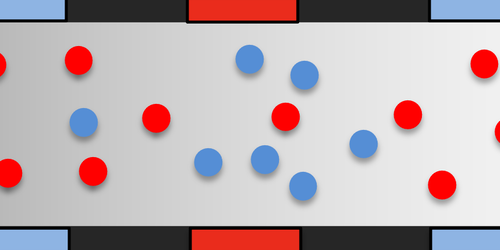Gated Flows in Charged Channels
The tiny channels in cellular membranes are sensitive sentinels to what enters and leaves a biological cell. These channels can regulate ion flows by adapting their shapes and can even stop the flow completely, acting like emergency shutoff valves. Efforts to mimic this biological capability have centered on altering the geometry of the nanochannels. Now Tine Curk of Johns Hopkins University in Maryland and his colleagues propose an alternative approach [1]. In numerical simulations, the researchers show that they can abruptly change the speed with which a pressure-driven charged fluid flows through a nanochannel by electrically patterning the walls of that channel. The finding could be used by others to create sensitive on-off flow valves for fluids moving in the nanofluidic channels found, for example, in biomedical and neuromorphic devices.
Curk and his team simulated a salt solution flowing through a straight rectangular channel with a width of around 5 nm. The inside walls of the channel were patterned with alternating bands of positive and negative electrical charges. The researchers studied what happened when they increased the pressure gradient driving the flow.
Tracking the velocity of the flow, Curk and his colleagues found that the velocity abruptly increased by an order of magnitude when the pressure gradient reached a threshold value. This value depended on the ion concentration and the channel width. The researchers linked the cause of this abrupt flow transition to the drag on the fluid. When the drag was dominated by electrostatic interactions between the wall and the fluid’s ions the velocity was lower than when the drag was dominated by hydrodynamic forces. The researchers say that this transition effect is distinct from other phenomena known to cause sudden transitions in the properties of a flowing fluid.
–Rachel Berkowitz
Rachel Berkowitz is a Corresponding Editor for Physics Magazine based in Vancouver, Canada.
References
- T. Curk et al., “Discontinuous transition in electrolyte flow through charge-patterned nanochannels,” Phys. Rev. Lett. 133, 078201 (2024).




